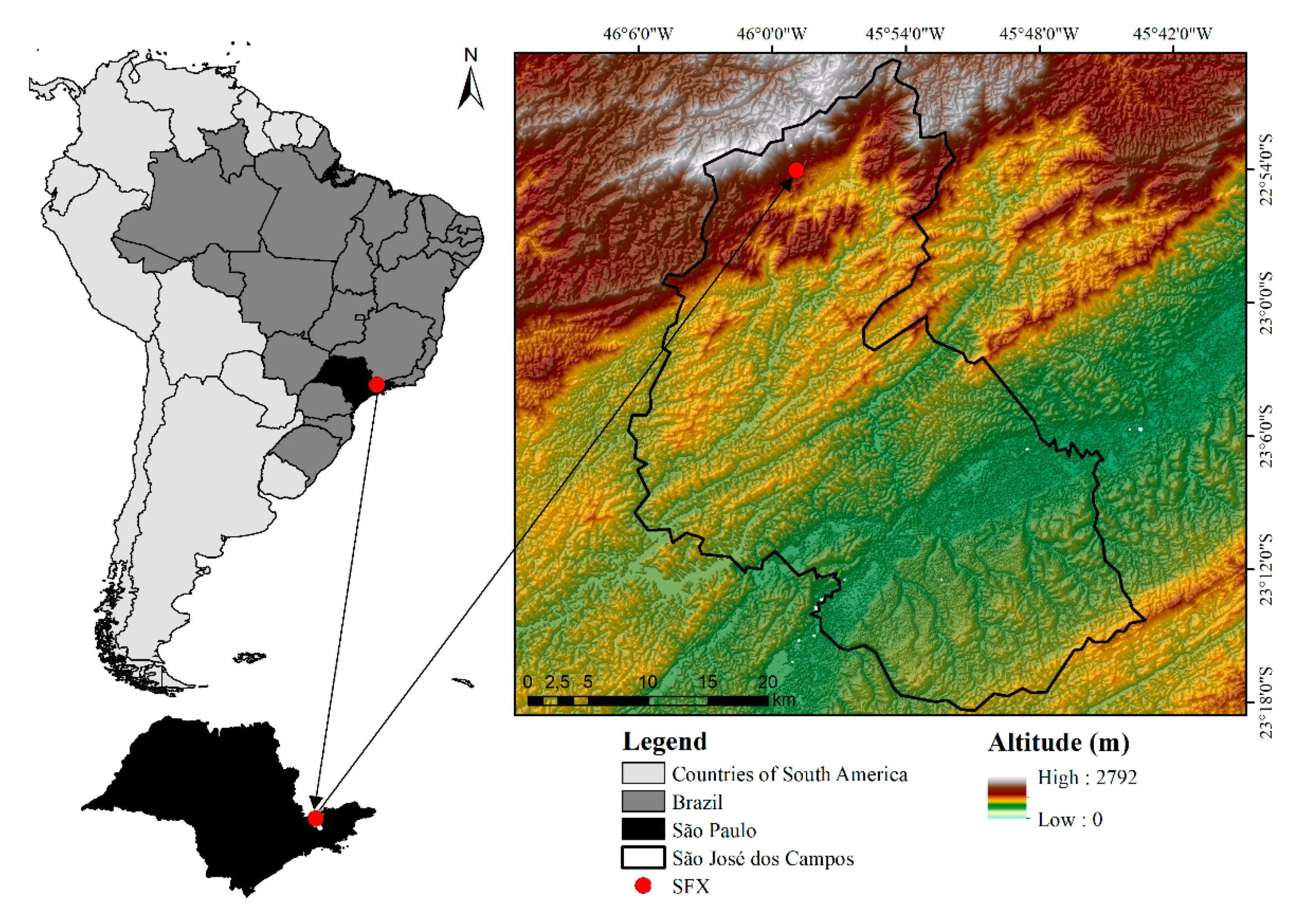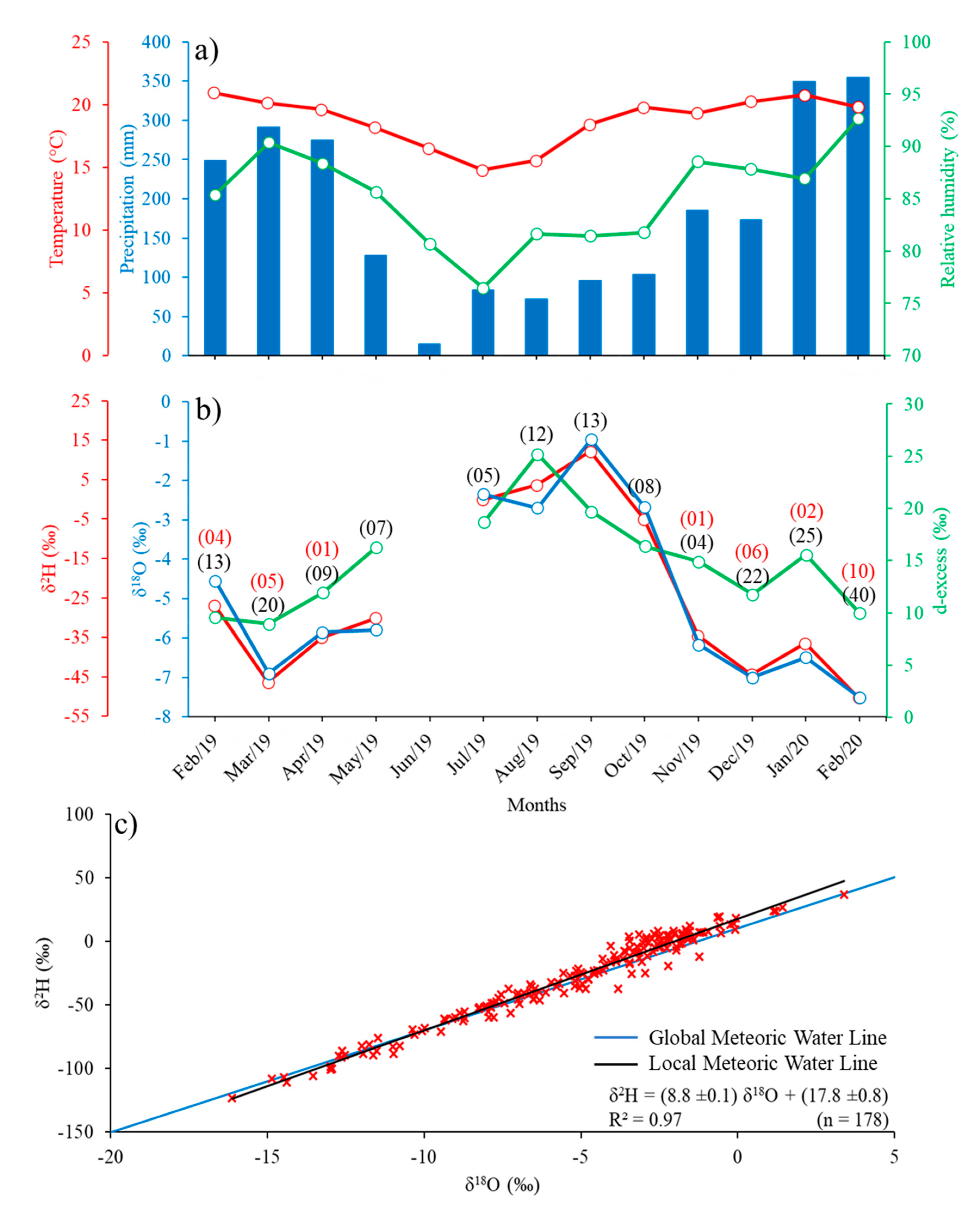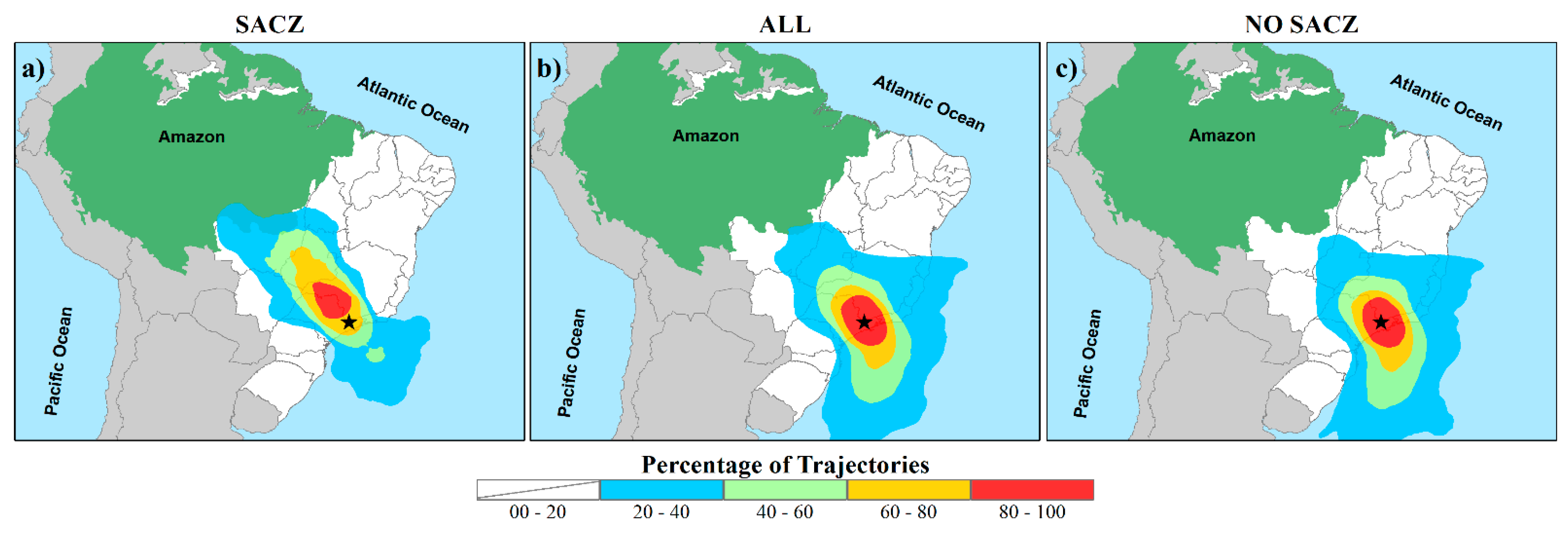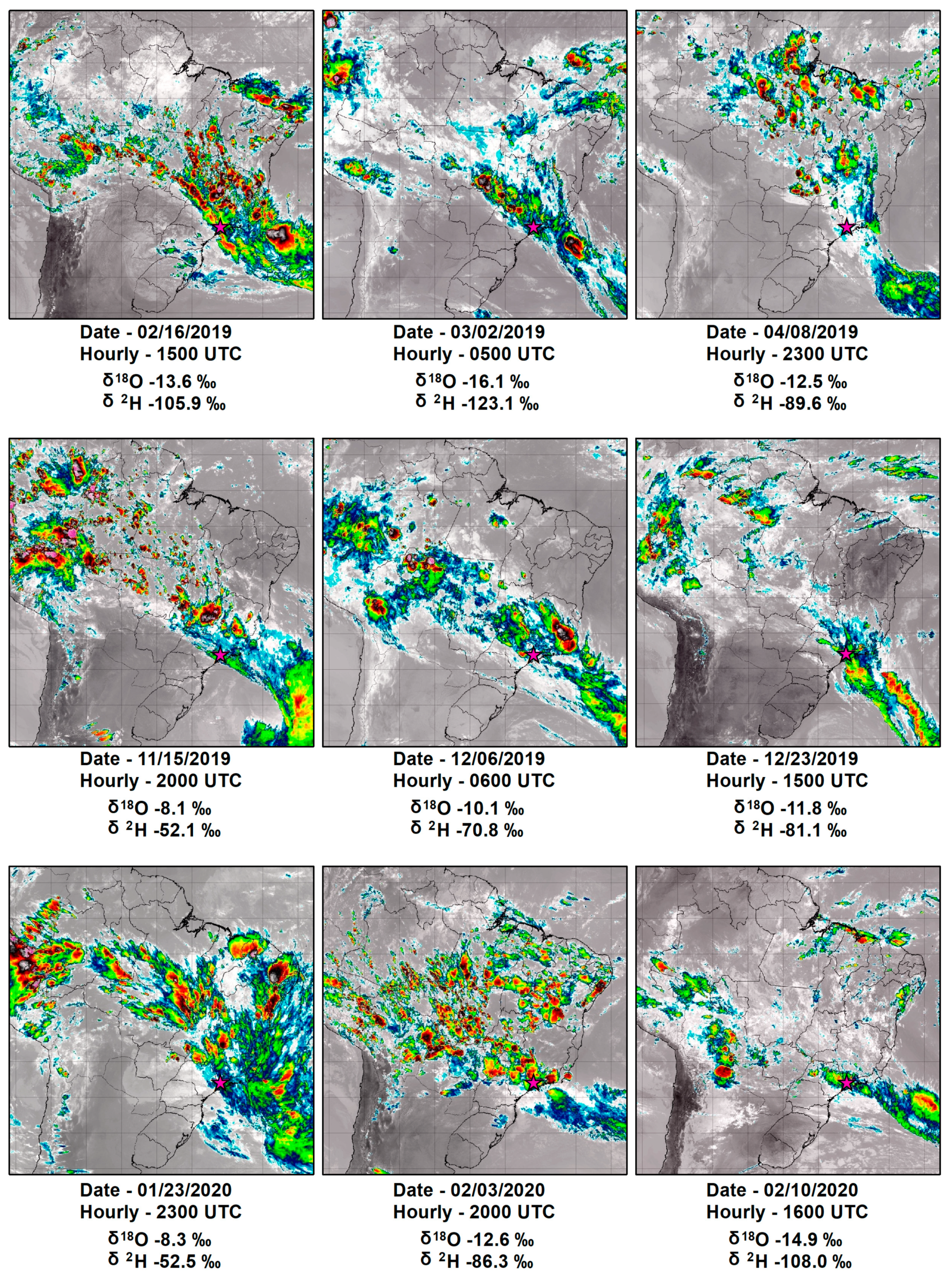Isotopic Composition of Precipitation in a Southeastern Region of Brazil during the Action of the South Atlantic Convergence Zone
Abstract
:1. Introduction
2. Materials and Methods
2.1. Study Region
2.2. Samples Collection
2.3. Isotopic Analysis
2.4. SACZ Events Determination and Meteorological Data
2.5. Air Mass Sources
2.6. Statistical Analysis
3. Results
3.1. Meteorological and Isotopic Characterization
3.2. Isotopic Composition during SACZ Events
3.3. Retrograde Trajectory of the Air Parcel
4. Discussion
4.1. Isotopic Seasonal Variability
4.2. Air Parcel Trajectory and Isotopic Signal of Precipitation during SACZ
5. Conclusions
Supplementary Materials
Author Contributions
Funding
Acknowledgments
Conflicts of Interest
References
- Dansgaard, W. Stable Isotopes in Precipitation. Tellus 1964, 16, 436–468. [Google Scholar] [CrossRef]
- Gibson, J.J.; Reid, R. Stable Isotope Fingerprint of Open-Water Evaporation Losses and Effective Drainage Area Fluctuations in a Subarctic Shield Watershed. J. Hydrol. 2010, 381, 142–150. [Google Scholar] [CrossRef]
- Criss, R.E.; Farquhar, J. Abundance, Notation, and Fractionation of Light Stable Isotopes. Rev. Mineral. Geochem. 2008, 68, 15–30. [Google Scholar] [CrossRef]
- Kong, Y.; Pang, Z. Evaluating the Sensitivity of Glacier Rivers to Climate Change Based on Hydrograph Separation of Discharge. J. Hydrol. 2012, 434–435, 121–129. [Google Scholar] [CrossRef]
- Lu, X.; Liang, L.L.; Wang, L.; Jenerette, G.D.; McCabe, M.F.; Grantz, D.A. Partitioning of Evapotranspiration Using a Stable Isotope Technique in an Arid and High Temperature Agricultural Production System. Agric. Water Manag. 2017, 179, 103–109. [Google Scholar] [CrossRef]
- Congjian, S.; Yaning, C.; Weihong, L.; Xingong, L.; Yuhui, Y. Isotopic Time Series Partitioning of Streamflow Components under Regional Climate Change in the Urumqi River, Northwest China. Hydrol. Sci. J. 2016, 61, 1443–1459. [Google Scholar] [CrossRef]
- Aemisegger, F.; Spiegel, J.K.; Pfahl, S.; Sodemann, H.; Eugster, W.; Wernli, H. Isotope Meteorology of Cold Front Passages: A Case Study Combining Observations and Modeling. Geophys. Res. Lett. 2015, 42, 5652–5660. [Google Scholar] [CrossRef]
- Crawford, J.; Hughes, C.E.; Parkes, S.D. Is the Isotopic Composition of Event Based Precipitation Driven by Moisture Source or Synoptic Scale Weather in the Sydney Basin, Australia? J. Hydrol. 2013, 507, 213–226. [Google Scholar] [CrossRef]
- Lykoudis, S.P.; Kostopoulou, E.; Argiriou, A.A. Stable Isotopic Signature of Precipitation under Various Synoptic Classifications. Phys. Chem. Earth Parts A/B/C 2010, 35, 530–535. [Google Scholar] [CrossRef]
- Berkelhammer, M.; Stott, L.; Yoshimura, K.; Johnson, K.; Sinha, A. Synoptic and Mesoscale Controls on the Isotopic Composition of Precipitation in the Western United States. Clim. Dyn. 2012, 38, 433–454. [Google Scholar] [CrossRef]
- Sánchez-Murillo, R.; Durán-Quesada, A.M. Preface to Stable Isotopes in Hydrological Studies in the Tropics: Ecohydrological Perspectives in a Changing Climate. Hydrol. Process. 2019, 33, 2160–2165. [Google Scholar] [CrossRef]
- Treble, P.C.; Budd, W.F.; Hope, P.K.; Rustomji, P.K. Synoptic-Scale Climate Patterns Associated with Rainfall δ18O in Southern Australia. J. Hydrol. 2005, 302, 270–282. [Google Scholar] [CrossRef]
- Cavalcanti, I.F.A. Large Scale and Synoptic Features Associated with Extreme Precipitation over South America: A Review and Case Studies for the First Decade of the 21st Century. Atmos. Res. 2012, 118, 27–40. [Google Scholar] [CrossRef]
- Ambrizzi, T.; Ferraz, S.E.T. An Objective Criterion for Determining the South Atlantic Convergence Zone. Front. Environ. Sci. 2015, 3. [Google Scholar] [CrossRef]
- Carvalho, L.M.V.; Jones, C.; Liebmann, B. The South Atlantic Convergence Zone: Intensity, Form, Persistence, and Relationships with Intraseasonal to Interannual Activity and Extreme Rainfall. J. Clim. 2004, 17, 88–108. [Google Scholar] [CrossRef]
- Kodama, Y. Large-Scale Common Features of Subtropical Precipitation Zones (the Baiu Frontal Zone, the SPCZ, and the SACZ) Part I: Characteristics of Subtropical Frontal Zones. J. Meteorol. Soc. Japan. Ser. II 1992, 70, 813–836. [Google Scholar] [CrossRef]
- Escobar, G.C.J. Zona de Convergência Do Atlântico Sul (ZCAS): Critério de Detecção Para Uso Em Centros Operacionais de Previsão de Tempo; INPE: São José dos Campos, Brazil, 2019; pp. 1–17. Available online: http://urlib.net/rep/8JMKD3MGP3W34R/3SGMUDP (accessed on 9 October 2019).
- Quadro, M.F.L.; Pezzi, L.P.; Rosa, E.B. O Climanálise e o Monitoramento Da ZCAS Nos Últimos 30 Anos. Rev. Climanálise 2016, 4, 19–25. Available online: http://climanalise.cptec.inpe.br/~rclimanl/revista/pdf/30anos/quadroetal.pdf (accessed on 7 October 2019).
- Chang, H.K.; Gonçalves, R.D.; Aggarwal, P.K.; Stradioto, M.R.; Hespanhol, E.C.B.; Sturchio, N.C.; Romatschke, U.; Araguas, L.J.A. Groundwater Isotope Ratios Reflect Convective and Stratiform (Paleo)Precipitation Fractions in Brazil. J. Hydrol. 2020, 585, 124801. [Google Scholar] [CrossRef]
- Dias, L.C.P.; Pimenta, F.M.; Santos, A.B.; Costa, M.H.; Ladle, R.J. Patterns of Land Use, Extensification, and Intensification of Brazilian Agriculture. Glob. Chang. Biol. 2016, 22, 2887–2903. [Google Scholar] [CrossRef]
- Gastmans, D.; Santos, V.; Galhardi, J.A.; Gromboni, J.F.; Batista, L.V.; Miotlinski, K.; Chang, H.K.; Govone, J.S. Controls over Spatial and Seasonal Variations on Isotopic Composition of the Precipitation along the Central and Eastern Portion of Brazil. Isot. Environ. Health Stud. 2017, 53, 518–538. [Google Scholar] [CrossRef]
- Santos, V.D.; Gastmans, D.; Sánchez-Murillo, R.; Felippe Gozzo, L.; Vianna Batista, L.; Lilla Manzione, R.; Martinez, J. Regional Atmospheric Dynamics Govern Interannual and Seasonal Stable Isotope Composition in Southeastern Brazil. J. Hydrol. 2019, 579, 124136. [Google Scholar] [CrossRef]
- Silva, R.F.B.D.; Rodrigues, M.D.A.; Vieira, S.A.; Batistella, M.; Farinaci, J. Perspectives for Environmental Conservation and Ecosystem Services on Coupled Rural–Urban Systems. Perspect. Ecol. Conserv. 2017, 15, 74–81. [Google Scholar] [CrossRef]
- Alvares, C.A.; Stape, J.L.; Sentelhas, P.C.; de Moraes Gonçalves, J.L.; Sparovek, G. Köppen’s Climate Classification Map for Brazil. Meteorol. Z. 2013, 22, 711–728. [Google Scholar] [CrossRef]
- INMET. (Brazilian National Meteorology Institute). Available online: https://portal.inmet.gov.br/ (accessed on 3 June 2020).
- ANA. (National Water Agency). Available online: http://www.snirh.gov.br/hidroweb/publico/medicoes_historicas_abas.jsf (accessed on 3 June 2020).
- Reboita, M.S.; Gan, M.A.; Rocha, R.P.D.; Ambrizzi, T. Regimes de Precipitação Na América Do Sul: Uma Revisão Bibliográfica. Rev. Bras. Meteorol. 2010, 25, 185–204. [Google Scholar] [CrossRef]
- Sun, X.; Cook, K.H.; Vizy, E.K. The South Atlantic Subtropical High: Climatology and Interannual Variability. J. Clim. 2017, 30, 3279–3296. [Google Scholar] [CrossRef]
- Morais, M.A.D.; Castro, W.A.C.D.; Tundisi, J.G. Climatologia de Frentes Frias Sobre a Região Metropolitana de São Paulo (RMSP), e Sua Influência Na Limnologia Dos Reservatórios de Abastecimento de Água. Rev. Bras. Meteorol. 2010, 25, 205–217. [Google Scholar] [CrossRef]
- Prechsl, U.E.; Gilgen, A.K.; Kahmen, A.; Buchmann, N. Reliability and Quality of Water Isotope Data Collected with a Low-Budget Rain Collector. Rapid Commun. Mass Spectrom. 2014, 28, 879–885. [Google Scholar] [CrossRef] [PubMed]
- GNIP (Global Network of Isotopes in Precipitation) IAEA/GNIP Precipitation Sampling Guide. Available online: http://www-naweb.iaea.org/napc/ih/documents/other/gnip_manual_v2.02_en_hq.pdf (accessed on 1 June 2018).
- Paul, D.; Skrzypek, G.; Fórizs, I. Normalization of Measured Stable Isotopic Compositions to Isotope Reference Scales a Review. Rapid Commun. Mass Spectrom. 2007, 21, 3006–3014. [Google Scholar] [CrossRef] [PubMed]
- Pierchala, A.; Rozanski, K.; Dulinski, M.; Gorczyca, Z.; Marzec, M.; Czub, R. High-Precision Measurements of δ2H, δ18O and δ17O in Water with the Aid of Cavity Ring-down Laser Spectroscopy. Isotopes Environ. Health Stud. 2019, 55, 290–307. [Google Scholar] [CrossRef] [PubMed]
- Coplen, T.B. Guidelines and Recommended Terms for Expression of Stable-Isotope-Ratio and Gas-Ratio Measurement Results. Rapid Commun. Mass Spectrom. 2011, 25, 2538–2560. [Google Scholar] [CrossRef] [PubMed]
- Satyamurty, P.; Rosa, M.B. Synoptic Climatology of Tropical and Subtropical South America and Adjoining Seas as Inferred from Geostationary Operational Environmental Satellite Imagery. Int. J. Climatol. 2020, 40, 378–399. [Google Scholar] [CrossRef]
- de Oliveira Vieira, S.; Satyamurty, P.; Andreoli, R.V. On the South Atlantic Convergence Zone Affecting Southern Amazonia in Austral Summer. Atmos. Sci. Lett. 2013, 14, 1–6. [Google Scholar] [CrossRef]
- Stein, A.F.; Draxler, R.R.; Rolph, G.D.; Stunder, B.J.B.; Cohen, M.D.; Ngan, F. NOAA’s HYSPLIT Atmospheric Transport and Dispersion Modeling System. Bull. Am. Meteorol. Soc. 2015, 96, 2059–2077. [Google Scholar] [CrossRef]
- Otte, I.; Detsch, F.; Gütlein, A.; Scholl, M.; Kiese, R.; Appelhans, T.; Nauss, T. Seasonality of Stable Isotope Composition of Atmospheric Water Input at the Southern Slopes of Mt. Kilimanjaro, Tanzania. Hydrol. Process. 2017, 31, 3932–3947. [Google Scholar] [CrossRef]
- Samuels-Crow, K.E.; Galewsky, J.; Hardy, D.R.; Sharp, Z.D.; Worden, J.; Braun, C. Upwind Convective Influences on the Isotopic Composition of Atmospheric Water Vapor over the Tropical Andes. J. Geophys. Res. Atmos. 2014, 119, 7051–7063. [Google Scholar] [CrossRef]
- Santos, V.; Dias de Oliveira, M.; Boll, J.; Sánchez-Murillo, R.; Menegário, A.A.; Gozzo, L.F.; Gastmans, D. Isotopic Composition of Precipitation during Strong El Niño–Southern Oscillation Events in the Southeast Region of Brazil. Hydrol. Process. 2019, 33, 647–660. [Google Scholar] [CrossRef]
- Rodell, M.; Houser, P.R.; Jambor, U.; Gottschalck, J.; Mitchell, K.; Meng, C.-J.; Arsenault, K.; Cosgrove, B.; Radakovich, J.; Bosilovich, M.; et al. The Global Land Data Assimilation System. Bull. Am. Meteorol. Soc. 2004, 85, 381–394. [Google Scholar] [CrossRef]
- Shapiro, S.S.; Wilk, M.B. An Analysis of Variance Test for Normality (Complete Samples). Biometrika 1965, 52, 591. [Google Scholar] [CrossRef]
- Sánchez-Murillo, R.; Birkel, C.; Welsh, K.; Esquivel-Hernández, G.; Corrales-Salazar, J.; Boll, J.; Brooks, E.; Roupsard, O.; Sáenz-Rosales, O.; Katchan, I.; et al. Key Drivers Controlling Stable Isotope Variations in Daily Precipitation of Costa Rica: Caribbean Sea versus Eastern Pacific Ocean Moisture Sources. Quat. Sci. Rev. 2016, 131, 250–261. [Google Scholar] [CrossRef]
- Weir, I. Spearman’s Correlation. Available online: http://www.statstutor.ac.uk/resources/uploaded/spearmans.pdf (accessed on 12 March 2019).
- Craig, H. Isotopic Variations in Meteoric Waters. Science. 1961, 133, 1702–1703. [Google Scholar] [CrossRef] [PubMed]
- Wu, H.; Zhang, X.; Xiaoyan, L.; Li, G.; Huang, Y. Seasonal Variations of Deuterium and Oxygen-18 Isotopes and Their Response to Moisture Source for Precipitation Events in the Subtropical Monsoon Region. Hydrol. Process. 2015, 29, 90–102. [Google Scholar] [CrossRef]
- Pfahl, S.; Sodemann, H. What Controls Deuterium Excess in Global Precipitation? Clim. Past 2014, 10, 771–781. [Google Scholar] [CrossRef]
- Adhikari, N.; Gao, J.; Yao, T.; Yang, Y.; Dai, D. The Main Controls of the Precipitation Stable Isotopes at Kathmandu, Nepal. Tellus B Chem. Phys. Meteorol. 2020, 72, 1–17. [Google Scholar] [CrossRef]
- Yeh, H.-F.; Lee, C.-H.; Hsu, K.-C. Oxygen and Hydrogen Isotopes for the Characteristics of Groundwater Recharge: A Case Study from the Chih-Pen Creek Basin, Taiwan. Environ. Earth Sci. 2011, 62, 393–402. [Google Scholar] [CrossRef]
- Putman, A.L.; Fiorella, R.P.; Bowen, G.J.; Cai, Z. A Global Perspective on Local Meteoric Water Lines: Meta-analytic Insight Into Fundamental Controls and Practical Constraints. Water Resour. Res. 2019, 55, 6896–6910. [Google Scholar] [CrossRef]
- Yang, Q.; Mu, H.; Guo, J.; Bao, X.; Martín, J.D. Temperature and Rainfall Amount Effects on Hydrogen and Oxygen Stable Isotope in Precipitation. Quat. Int. 2019. [Google Scholar] [CrossRef]
- Chen, F.; Zhang, M.; Wang, S.; Ma, Q.; Zhu, X.; Dong, L. Relationship between Sub-Cloud Secondary Evaporation and Stable Isotopes in Precipitation of Lanzhou and Surrounding Area. Quat. Int. 2015, 380–381, 68–74. [Google Scholar] [CrossRef]
- Baker, J.C.A.; Gloor, M.; Spracklen, D.V.; Arnold, S.R.; Tindall, J.C.; Clerici, S.J.; Leng, M.J.; Brienen, R.J.W. What Drives Interannual Variation in Tree Ring Oxygen Isotopes in the Amazon? Geophys. Res. Lett. 2016, 43. [Google Scholar] [CrossRef]
- Araguás-Araguás, L.; Froehlich, K.; Rozanski, K. Stable Isotope Composition of Precipitation over Southeast Asia. J. Geophys. Res. Atmos. 1998, 103, 28721–28742. [Google Scholar] [CrossRef]
- Zhao, P.; Tan, L.; Zhang, P.; Wang, S.; Cui, B.; Li, D.; Xue, G.; Cheng, X. Stable Isotopic Characteristics and Influencing Factors in Precipitation in the Monsoon Marginal Region of Northern China. Atmosphere 2018, 9, 97. [Google Scholar] [CrossRef]
- Liu, J.; Song, X.; Yuan, G.; Sun, X.; Liu, X.; Wang, S. Characteristics of δ18O in Precipitation over Eastern Monsoon China and the Water Vapor Sources. Chin. Sci. Bull. 2010, 55, 200–211. [Google Scholar] [CrossRef]
- Bershaw, J. Controls on Deuterium Excess across Asia. Geosciences 2018, 8, 257. [Google Scholar] [CrossRef]
- Guan, H.; Zhang, X.; Skrzypek, G.; Sun, Z.; Xu, X. Deuterium Excess Variations of Rainfall Events in a Coastal Area of South Australia and Its Relationship with Synoptic Weather Systems and Atmospheric Moisture Sources. J. Geophys. Res. Atmos. 2013, 118, 1123–1138. [Google Scholar] [CrossRef]
- Uemura, R.; Matsui, Y.; Yoshimura, K.; Motoyama, H.; Yoshida, N. Evidence of Deuterium Excess in Water Vapor as an Indicator of Ocean Surface Conditions. J. Geophys. Res. 2008, 113, D19114. [Google Scholar] [CrossRef]
- Li, Z.-J.; Li, Z.-X.; Yu, H.-C.; Song, L.-L.; Ma, J.-Z. Environmental Significance and Zonal Characteristics of Stable Isotope of Atmospheric Precipitation in Arid Central Asia. Atmos. Res. 2019, 227, 24–40. [Google Scholar] [CrossRef]
- Escobar, G.C.J.; Reboita, M.S.; Souza, A. Climatology of Surface Baroclinic Zones in the Coast of Brazil. Atmósfera 2019, 32, 129–141. [Google Scholar] [CrossRef]
- Foss, M.; Chou, S.C.; Seluchi, M.E. Interaction of Cold Fronts with the Brazilian Plateau: A Climatological Analysis. Int. J. Climatol. 2017, 37, 3644–3659. [Google Scholar] [CrossRef]
- Vera, C.S.; Vigliarolo, P.K.; Berbery, E.H. Cold Season Synoptic-Scale Waves over Subtropical South America. Mon. Weather Rev. 2002, 130, 684–699. [Google Scholar] [CrossRef]
- Reboita, M.S.; Ambrizzi, T.; Silva, B.A.; Pinheiro, R.F.; da Rocha, R.P. The South Atlantic Subtropical Anticyclone: Present and Future Climate. Front. Earth Sci. 2019, 7. [Google Scholar] [CrossRef]
- Arraut, J.M.; Nobre, C.; Barbosa, H.M.J.; Obregon, G.; Marengo, J. Aerial Rivers and Lakes: Looking at Large-Scale Moisture Transport and Its Relation to Amazonia and to Subtropical Rainfall in South America. J. Clim. 2012, 25, 543–556. [Google Scholar] [CrossRef]
- Carvalho, L.M.V.; Silva, A.E.; Jones, C.; Liebmann, B.; Silva Dias, P.L.; Rocha, H.R. Moisture Transport and Intraseasonal Variability in the South America Monsoon System. Clim. Dyn. 2011, 36, 1865–1880. [Google Scholar] [CrossRef]
- Kodama, Y.-M.; Sagawa, T.; Ishida, S.; Yoshikane, T. Roles of the Brazilian Plateau in the Formation of the SACZ. J. Clim. 2012, 25, 1745–1758. [Google Scholar] [CrossRef]
- Quadro, M.F.L.d.; da Silva Dias, M.A.F.; Herdies, D.L.; de Gonçalves, L.G.G. Análise Climatológica Da Precipitação e Do Transporte de Umidade Na Região Da ZCAS Através Da Nova Geração de Reanálises. Rev. Bras. Meteorol. 2012, 27, 152–162. [Google Scholar] [CrossRef]
- Pearce, F. Rivers in the Sky. New Sci. 2019, 244, 40–43. [Google Scholar] [CrossRef]
- Bergier, I.; Assine, M.L.; McGlue, M.M.; Alho, C.J.R.; Silva, A.; Guerreiro, R.L.; Carvalho, J.C. Amazon Rainforest Modulation of Water Security in the Pantanal Wetland. Sci. Total Environ. 2018, 619–620, 1116–1125. [Google Scholar] [CrossRef]
- Ruiz-Vásquez, M.; Arias, P.A.; Martínez, J.A.; Espinoza, J.C. Effects of Amazon Basin Deforestation on Regional Atmospheric Circulation and Water Vapor Transport towards Tropical South America. Clim. Dyn. 2020, 54, 4169–4189. [Google Scholar] [CrossRef]
- Stumpp, C.; Klaus, J.; Stichler, W. Analysis of Long-Term Stable Isotopic Composition in German Precipitation. J. Hydrol. 2014, 517, 351–361. [Google Scholar] [CrossRef]
- Giustini, F.; Brilli, M.; Patera, A. Mapping Oxygen Stable Isotopes of Precipitation in Italy. J. Hydrol. Reg. Stud. 2016, 8, 162–181. [Google Scholar] [CrossRef]
- Galewsky, J.; Steen-Larsen, H.C.; Field, R.D.; Worden, J.; Risi, C.; Schneider, M. Stable Isotopes in Atmospheric Water Vapor and Applications to the Hydrologic Cycle. Rev. Geophys. 2016, 54, 809–865. [Google Scholar] [CrossRef] [PubMed]
- Salati, E.; Dall’Olio, A.; Matsui, E.; Gat, J.R. Recycling of Water in the Amazon Basin: An Isotopic Study. Water Resour. Res. 1979, 15, 1250–1258. [Google Scholar] [CrossRef]
- Gat, J.R.; Matsui, E. Atmospheric Water Balance in the Amazon Basin: An Isotopic Evapotranspiration Model. J. Geophys. Res. 1991, 96, 13179. [Google Scholar] [CrossRef]
- Pattnayak, K.C.; Tindall, J.C.; Brienen, R.J.W.; Barichivich, J.; Gloor, E. Can We Detect Changes in Amazon Forest Structure Using Measurements of the Isotopic Composition of Precipitation? Geophys. Res. Lett. 2019, 46, 14807–14816. [Google Scholar] [CrossRef]
- Zhu, G.; Guo, H.; Qin, D.; Pan, H.; Zhang, Y.; Jia, W.; Ma, X. Contribution of Recycled Moisture to Precipitation in the Monsoon Marginal Zone: Estimate Based on Stable Isotope Data. J. Hydrol. 2019, 569, 423–435. [Google Scholar] [CrossRef]
- Njitchoua, R.; Sigha-Nkamdjou, L.; Dever, L.; Marlin, C.; Sighomnou, D.; Nia, P. Variations of the Stable Isotopic Compositions of Rainfall Events from the Cameroon Rain Forest, Central Africa. J. Hydrol. 1999, 223, 17–26. [Google Scholar] [CrossRef]
- Kern, Z.; Hatvani, I.; Czuppon, G.; Fórizs, I.; Erdélyi, D.; Kanduč, T.; Palcsu, L.; Vreča, P. Isotopic ‘Altitude’ and ‘Continental’ Effects in Modern Precipitation across the Adriatic–Pannonian Region. Water 2020, 12, 1797. [Google Scholar] [CrossRef]
- Rozanski, K.; Araguás-Araguás, L.; Gonfiantini, R. Isotopic Patterns in Modern Global Precipitation. Geophys. Monogr. 1993, 78, 1–36. [Google Scholar] [CrossRef]
- Durieux, L. The Impact of Deforestation on Cloud Cover over the Amazon Arc of Deforestation. Remote Sens. Environ. 2003, 86, 132–140. [Google Scholar] [CrossRef]
- Dias, L.C.P.; Macedo, M.N.; Costa, M.H.; Coe, M.T.; Neill, C. Effects of Land Cover Change on Evapotranspiration and Streamflow of Small Catchments in the Upper Xingu River Basin, Central Brazil. J. Hydrol. Reg. Stud. 2015, 4, 108–122. [Google Scholar] [CrossRef]
- O’Connor, J.; Santos, M.J.; Rebel, K.T.; Dekker, S.C. The Influence of Water Table Depth on Evapotranspiration in the Amazon Arc of Deforestation. Hydrol. Earth Syst. Sci. 2019, 23, 3917–3931. [Google Scholar] [CrossRef]
- Farinosi, F.; Arias, M.E.; Lee, E.; Longo, M.; Pereira, F.F.; Livino, A.; Moorcroft, P.R.; Briscoe, J. Future Climate and Land Use Change Impacts on River Flows in the Tapajós Basin in the Brazilian Amazon. Earth’s Future 2019, 7, 993–1017. [Google Scholar] [CrossRef]
- Azevedo-Ramos, C.; Moutinho, P.; Arruda, V.L.D.S.; Stabile, M.C.C.; Alencar, A.; Castro, I.; Ribeiro, J.P. Lawless Land in No Man’s Land: The Undesignated Public Forests in the Brazilian Amazon. Land Use Policy 2020, 99, 104863. [Google Scholar] [CrossRef]
- Reydon, B.P.; Fernandes, V.B.; Telles, T.S. Land Governance as a Precondition for Decreasing Deforestation in the Brazilian Amazon. Land Use Policy 2020, 94, 104313. [Google Scholar] [CrossRef]
- Peng, T.-R.; Liu, K.-K.; Wang, C.-H.; Chuang, K.-H. A Water Isotope Approach to Assessing Moisture Recycling in the Island-Based Precipitation of Taiwan: A Case Study in the Western Pacific. Water Resour. Res. 2011, 47. [Google Scholar] [CrossRef]
- Wang, S.; Zhang, M.; Che, Y.; Chen, F.; Qiang, F. Contribution of Recycled Moisture to Precipitation in Oases of Arid Central Asia: A Stable Isotope Approach. Water Resour. Res. 2016, 52, 3246–3257. [Google Scholar] [CrossRef]





| Spearman Value (+ or −) | Interpretation of the Degree of Correlation |
|---|---|
| 0.00 a 0.19 | Very weak |
| 0.20 a 0.39 | Weak |
| 0.40 a 0.59 | Moderate |
| 0.60 a 0.79 | Strong |
| 0.80 a 1.00 | Very strong |
| Meteorological Variables | δ18O (‰) | δ2H (‰) | d-excess (‰) | |||
|---|---|---|---|---|---|---|
| rs | p-Value | rs | p-Value | rs | p-Value | |
| Precipitation (mm) | −0.80 | 0.003 | −0.87 | <0.001 | −0.81 | 0.002 |
| Relative humidity (%) | −0.91 | <0.001 | −0.92 | <0.001 | −0.78 | 0.004 |
| Temperature (°C) | −0.58 | 0.052 | −0.61 | 0.040 | −0.76 | 0.007 |
| Event | Date | N° of Samples | δ18O (‰) | δ2H (‰) | d-excess (‰) | Precipitation (mm) | Air Temperature (°C) | Relative Humidity (%) |
|---|---|---|---|---|---|---|---|---|
| 1 | 16 Feb 2019 | 2 | −9.0 ± 4.1 | −69.4 ± 32.7 | 2.6 ± 0.1 | 19.8 | 19.6 | 98 |
| 2 | 27 Feb–03 Mar 2019 | 7 | −12.6 ± 4.5 | −96.4 ± 35.7 | 4.6 ± 1.7 | 41.2 | 18.9 | 95 |
| 3 | 08 Apr 2019 | 1 | −12.5 | −89.6 | 10.6 | 8.8 | 17.5 | 100 |
| 4 | 15 Nov 2019 | 1 | −8.1 | −52.1 | 12.6 | 28.2 | 17.5 | 99 |
| 5 | 05 Dec–06 Dec 2019 | 4 | −7.7 ± 2.0 | −51.9 ± 17.9 | 9.6 ± 2.7 | 39.4 | 18.7 | 98 |
| 6 | 23 Dec 2019 | 2 | −8.5 ± 2.9 | −54.4 ± 23.7 | 13.7 ± 0.7 | 34.8 | 18.1 | 100 |
| 7 | 23 Jan 2020 | 2 | −7.9 ± 0.3 | −49.9 ± 3.0 | 13.9 ± 0.3 | 5.2 | 17.4 | 100 |
| 8 | 03 Feb–04 Feb 2020 | 4 | −11.9 ± 1.5 | −82.5 ± 11.7 | 12.7 ± 4.9 | 32.4 | 19.9 | 98 |
| 9 | 09 Feb–11 Feb 2020 | 6 | −10.9 ± 3.1 | −76.9 ± 26.4 | 10.4 ± 2.6 | 80.6 | 18.5 | 99 |
Publisher’s Note: MDPI stays neutral with regard to jurisdictional claims in published maps and institutional affiliations. |
© 2021 by the authors. Licensee MDPI, Basel, Switzerland. This article is an open access article distributed under the terms and conditions of the Creative Commons Attribution (CC BY) license (http://creativecommons.org/licenses/by/4.0/).
Share and Cite
Santos, C.; Carneiro, R.; Borges, C.; Gastmans, D.; Borma, L. Isotopic Composition of Precipitation in a Southeastern Region of Brazil during the Action of the South Atlantic Convergence Zone. Atmosphere 2021, 12, 418. https://doi.org/10.3390/atmos12040418
Santos C, Carneiro R, Borges C, Gastmans D, Borma L. Isotopic Composition of Precipitation in a Southeastern Region of Brazil during the Action of the South Atlantic Convergence Zone. Atmosphere. 2021; 12(4):418. https://doi.org/10.3390/atmos12040418
Chicago/Turabian StyleSantos, Cleber, Rayonil Carneiro, Camilla Borges, Didier Gastmans, and Laura Borma. 2021. "Isotopic Composition of Precipitation in a Southeastern Region of Brazil during the Action of the South Atlantic Convergence Zone" Atmosphere 12, no. 4: 418. https://doi.org/10.3390/atmos12040418







